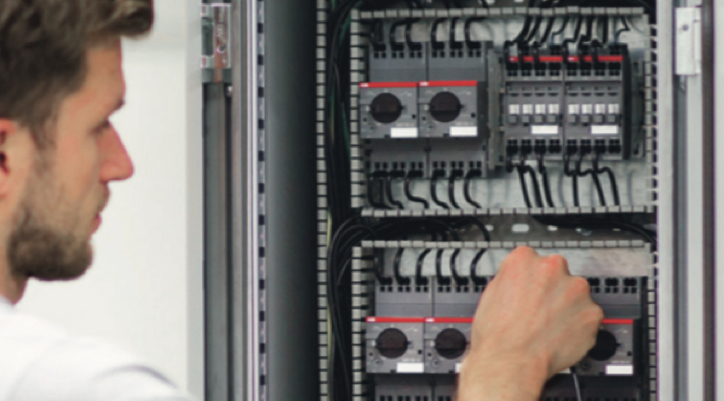Benefits of more-compact panels
Rich Gibson
Product Marketing Manager
ABB Jokab Safety Products
Actions to solve one problem often have other, unexpected consequences. Panel builders opt for digital components primarily to create more-compact panels. But they also discover other unexpected additional benefits of interest to both panel builders and buyers. Here are 3 unexpected benefits of more-compact panels.
People often do things trying to solve a problem and are surprised when something else – something unexpected – also occurs. This is the principle of unintended consequences, and those outcomes can be either good or bad.
A great example of a negative unintended outcome is readily visible on any drive through the southeastern United States. Along the road you are bound to see many trees being strangled by kudzu vines. In the 1930s, farmers were encouraged to plant kudzu as a way to stop erosion. Unfortunately, the fast-growing vine often overtakes native trees, completely robbing them of sunlight and eventually killing them.
Panel builders with tight space limitations typically turn to the current generation of solid-state devices to solve their problem. These devices are typically much more compact than their analog predecessors, achieving size-reduction goals. But builders are discovering that along with the smaller size they also benefit from a number of unintended consequences, all of them good.
Reduced power consumption
Everyone is aware of the amazing power reduction and longer life provided by today’s LED bulbs compared to incandescents. Relying on digital panel components rather than older, electromechanical components provides the same kind of benefits. Power consumption is far less for the digital device. Digital panel components also generate far less heat, which reduces or possibly eliminates the need for auxiliary cooling. And components that run cooler tend to last longer.
Energy efficiency is something every panel owner should be interested in, but it’s especially important in renewable energy applications where every watt lost is a watt that can’t be sold.
“We are working with the market to develop a 2-pole, 1,500 VDC switch to replace the commonly used 3-pole switch,” says Wellington Rodrigues, ABB’s product marketing manager – disconnect switches. “These switches are up to 35% more efficient in terms of power loss. Imagine a utility-scale solar plant where there’s typically hundreds to thousands of those installed. That means much more power going to the grid for sale.”
Increased reliability
Digital devices are typically more functionally dense than analog components. A single safety PLC, for example, can do the job of 10 traditional safety relays. The reliability benefit of one component replacing 10 is obvious. Digital devices also often combine functions otherwise provided by multiple components. An electronic motor starter can also include contactors and overloads, for example. Again, that means fewer components and fewer potential points of failure. And these digital motor starters do the job with a device that’s about half the size of a traditional starter.
“Each safety relay has around 40 wiring points,” says Rich Gibson, ABB’s product marketing manager – Jokab Safety Products. “A safety PLC may have as many as 60 connections but does the job of 10 relays. When you do the math for a panel with 10 relays, you’ll see that a safety PLC reduces the number of wire connections from 400 to 60. That’s a significant wiring reduction and reliability improvement.”
It should also be obvious that a solid-state PLC is far less prone to failure than the electromechanical version. Fewer, more reliable components result in greater overall system reliability.
Simpler installation and maintenance
“Having fewer components points out a pair of positive, but probably unintended, consequences; simpler installation; and maintenance,” explains Chris Lovell, ABB product marketing – EPPC North America. “Since there are fewer components, that naturally reduces the time required for installation. Many current-generation devices are designed to stack, mate, or connect via bus bars. Reducing the number of terminal blocks and wire connections eliminates dozens and possibly hundreds of potential points of failure.”
Panels built using current-generation digital components are also lighter, easier to work with, and less costly to ship.
Maintenance for panel owners is simplified not only because there are fewer, more reliable components, but also because digital devices typically include built-in diagnostics. Techs can often merely check the LEDs to assess and quickly resolve equipment problems.
Smaller size brings unintended benefits
Panel owners in most applications have no concern about space. Industrial and process facilities, for example, typically have plenty of room for equipment. Still, in light of all the additional benefits realized with panels comprised of the current generation of smaller, digital devices, all users should consider specifying more-compact panels.
Depending on the application, there may be no additional cost for these diminutive digital components and downsized panels. In some cases, the current and traditional components are comparably priced. Even when the smaller components do cost more, the differential is often offset by the reduction of components. On top of that are the savings to the builder from faster assembly, less copper, and smaller enclosures – and to the user from improved energy efficiency and reduced maintenance.
Whether driven by the need for more reliability or more-compact panels, equipment owners are discovering that, in addition to fulfilling their primary requirement, they also benefit from important, positive, but unintended consequences.


